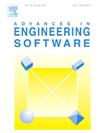From density to CAD: Automatic and robust CAD model generation of topology optimization results via sparse optimization
IF 5.7
2区 工程技术
Q2 COMPUTER SCIENCE, INTERDISCIPLINARY APPLICATIONS
引用次数: 0
Abstract
Topology optimization (TO) is a mature design technique that provides a conceptual design with the desired structural performance. However, the raw TO results cannot be interactively fine-tuned for conceptual design or further post-processing. This paper proposes an automatic and effective framework that can convert TO results into editable CAD models. The marching cubes algorithm is utilized to obtain discrete boundary points, which are subsequently transformed into CAD format via the sparse curve fitting technique. The proposed framework ensures robust and automatic reconstruction of the TO results of macrostructures and microstructures, especially complex small-scale structures with tiny holes and a few extracted points. We developed a Rhino plug-in, facilitating designers to modify the structural layout and intuitively assess the performance of the editable structures. Furthermore, we address stress concentrations by editing the reconstructed CAD models to illustrate the application of the proposed method.
从密度到CAD:通过稀疏优化实现拓扑优化结果的自动鲁棒CAD模型生成
拓扑优化(TO)是一种成熟的设计技术,它可以提供具有理想结构性能的概念设计。然而,原始的TO结果不能交互式地对概念设计或进一步的后处理进行微调。本文提出了一个自动有效的框架,可以将TO结果转换为可编辑的CAD模型。采用移动立方体算法获得离散边界点,然后通过稀疏曲线拟合技术将其转换为CAD格式。该框架保证了宏观结构和微观结构,特别是具有微小孔洞和少量提取点的复杂小尺度结构的TO结果的鲁棒性和自动重建。我们开发了一个Rhino插件,方便设计人员修改结构布局并直观地评估可编辑结构的性能。此外,我们通过编辑重建的CAD模型来解决应力集中问题,以说明所提出方法的应用。
本文章由计算机程序翻译,如有差异,请以英文原文为准。
求助全文
约1分钟内获得全文
求助全文
来源期刊

Advances in Engineering Software
工程技术-计算机:跨学科应用
CiteScore
7.70
自引率
4.20%
发文量
169
审稿时长
37 days
期刊介绍:
The objective of this journal is to communicate recent and projected advances in computer-based engineering techniques. The fields covered include mechanical, aerospace, civil and environmental engineering, with an emphasis on research and development leading to practical problem-solving.
The scope of the journal includes:
• Innovative computational strategies and numerical algorithms for large-scale engineering problems
• Analysis and simulation techniques and systems
• Model and mesh generation
• Control of the accuracy, stability and efficiency of computational process
• Exploitation of new computing environments (eg distributed hetergeneous and collaborative computing)
• Advanced visualization techniques, virtual environments and prototyping
• Applications of AI, knowledge-based systems, computational intelligence, including fuzzy logic, neural networks and evolutionary computations
• Application of object-oriented technology to engineering problems
• Intelligent human computer interfaces
• Design automation, multidisciplinary design and optimization
• CAD, CAE and integrated process and product development systems
• Quality and reliability.
 求助内容:
求助内容: 应助结果提醒方式:
应助结果提醒方式:


